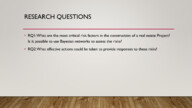 | EasyChair Smart Slide | User Guide/Log in |
| Home |

This study aims to show the importance of developing and making compatible complementary projects using BIM (Building Information Modeling) and to analyze the risks on the costs and schedule during the execution of a real estate development. The study also shows that advanced response to risks improves performance, increases assertiveness in the work, minimize waste of material, rework and unnecessary wear and tear. Construction work is very complex, teams from various disciplines are involved, and a compatibility of projects is necessary to minimize execution errors and risks during the construction. The performance of a real estate project is affected by the lack of compatibility of complementary projects using the BIM (Building Information Modeling) methodology, generating conflicts between the disciplines, rework, cost and time overflows. As a methodological approach, an in-depth literature review and a case study was conducted. The first step in the case study was to map out the whole construction process, then analyze the risks present in each step. The probability of existing risks at each stage was combined using (BBN) and the impact were analyzed Analytic Hierarchy Process (AHP). This study is a source of information for professionals and companies planning to invest in BIM as support for decision making and shows the benefits in the practice.











